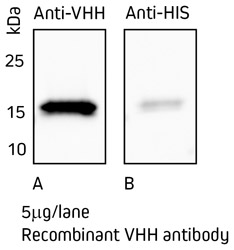Single Domain Antibodies, also known as Nanobodies or Nanoantibodies (nAb) are getting more recognition in life sciences, due to their unique biological properties. Secondary antibodies against Alpaca IgG, Subclasses and VHH domain antibodies (variable domain heavy chain-only antibodies) help to optimize VHH-Antibody / single domain antibodies / nAb development and allow a more effective detection of this antibody class compared to other methods.
VHH antibodies
Immunoglobulins derived from camelid species such as alpaca and llama have unique qualities that have been exploited for creation of engineered antibodies. Since the first successful isolation of heavy chain antibodies, researchers have focused on the rather small (12-15 kDa) but highly specific antigen-binding VHH domain as a new model for recombinant antibody (Nanobodies*) production. Several distinguishing characteristics of VHH antibodies are their ability to cross the blood-brain barrier, good tissue penetration together with detection of antigens within the cytosol, and to bind targets tightly through a long CDR3 loop.
VHH antibodies are easy to clone and can be produced at high levels in recombinant systems, have high solubility and are stable to pH extremes. Given their unique properties, single-domain antibodies are being used in a variety of applications including diagnostic kits to detect small molecules, as biosensors and in numerous medical applications such as cancer treatment. VHH antibodies are powerful tools for discovery.
Generation of VHH antibody libraries from camelids

VHH antibodies are developed following the well-established protocol shown above. Anti-Alpaca antibodies from Jackson ImmunoResearch can be used at different stages to optimize and expedite the production of high affinity VHH antibodies. The success and speed of discovering high quality VHH candidates is enhanced by the fidelity and utility of the tools utilized at each step.
Optimize PBMC isolation using Goat IgG anti-Alpaca IgG2+IgG3

Anti-Alpaca IgG and IgG2 + IgG3 specific antibodies allow to time PBMC harvest for an optimized VHH library construction. The VHH domain is located on heavy-chain antibodies only. IgG2 and IgG3 subclass response can mature differently from total IgG, and monitoring serum conversion of these antibodies can inform the decision to harvest lymphocytes.
Learn more about optimization and new opportunities with IgG2- and IgG3- subclass specific antibodies.
Improved detection of VHH antibodies using Goat IgG anti-Alpaca IgG (VHH)

Anti-Alpaca IgG (VHH) specific antibodies show an enhanced signal compared to an anti-tag antibody.
Polyclonal antibodies recognize several epitopes and deliver more molecules (e.g. enzymes or fluorophores) on a single VHH domain than antibodies narrowly focused on small peptide sequences. In this figure, a His6 tagged recombinant VHH was detected by western blot using Goat Anti-VHH domain antibody or an anti-His6 antibody.
Enhanced validation of VHH expression and binding activity

Significant signal can be obtained even at low VHH concentrations.
Screening VHH-expressing clones for binding activity and solubility is normally done by ELISA. In this figure, VHH was titrated across its coated immunogen and detected with Goat IgG anti-Alpaca IgG (VHH)-HRPO secondary antibody.
Anti-Alpaca IgG Secondary Antibodies
| wdt_ID | Secondary Antibody | Art.-Nr. |
|---|---|---|
| 1 | Goat IgG anti-Alpaca IgG (H+L) ** | 128-005-003 |
| 2 | Goat IgG anti-Alpaca IgG(H+L) [MinX Bo,Hu,Ms,Rb,Rt] ** | 128-005-160 |
| 3 | Goat IgG anti-Alpaca IgG2+IgG3 [MinX Bo,Hu,Ms,Rb,Rt] ** | 128-005-229 |
| 4 | Goat IgG anti-Alpaca IgG (VHH) [MinX Bo] | 128-005-232 |
| 5 | Goat IgG anti-Alpaca IgG (VHH) [MinX Bo,Hu,Ms,Rb,Rt] | 128-005-230 |
Anti-Alpaca IgG antibodies from Jackson ImmunoResearch recognize specifically both alpaca and llama IgG (H+L), IgG2- and IgG3-Subclasses, or VHH domain.
** Please note, these antibodies react primarily with the Fc region, and are not recommended for detection of VHH antibodies.
Anti-Alpaca IgG secondary antibodies are available with the following conjugates:
• Unconjugated
• Horseradish Peroxidase
• Alkaline Phosphatase
• Biotin
• DyLight™ 405
• Alexa Fluor® 488
• Fluorescein (FITC)
• Cy™ 3
• R-Phycoerythrin
• Alexa Fluor® 594
• Rhodamine Red-X™
• Alexa Fluor® 647
• Cy™ 5
AffiniPure™ Antibodies is trademark of Jackson ImmunoResearch Laboratories, Inc.
*Nanobody and Nanobodies are registered trademarks of Ablynx N.V
DyLight™ fluorescent dyes is a trademark of Thermo Fisher Scientific.
Cy™ is a registered trademark of GE Healthcare.
Rhodamine Red™-X is a trademark of Invitrogen.
Alexa Fluor® is a trademark of Life Technologies Corp.
Images property Jackson ImmunoResearch Laboratories, Inc.
